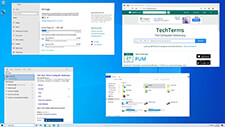Windows
Windows is a desktop operating system developed by Microsoft. For the past three decades, Windows has been the most popular operating system for personal computers.
Each version of Windows comes with a graphical user interface that includes a desktop with icons and a task bar that is displayed at the bottom of the screen by default. The Windows "File Explorer" allows users to open multiple windows, browse folders, and open files and applications. Most Windows versions include a Start menu, which provides quick access to files, settings, and the Windows search feature.
The first version of Windows was released in 1985. Since then, the OS has gone through several major updates. A few of the most notable Windows releases include:
- Windows 3.1 (1992)
- Windows 95 (1995)
- Windows XP (2001)
- Windows 7 (2009)
- Windows 10 (2015)
- Windows 11 (2021)
The above versions of Windows had long lifespans and were well-received by users. Some of the less-popular versions of Windows, which had shorter lifespans, include:
- Windows 98 (1998)
- Windows Me (2000)
- Windows Vista (2006)
- Windows 8 (2012)
Microsoft has released most versions of Windows with multiple editions, tailored for different users. For example, Windows 11 is available in "Home" and "Pro" editions. The Home edition is sufficient for most users, while the Pro edition includes additional networking and administrative features useful in corporate workspaces.
Windows runs on standard x86 hardware, such as Intel and AMD processors. Unlike Apple, Microsoft licenses the OS to multiple manufacturers. Therefore, numerous companies, such as Dell, HP, Acer, Asus, and Lenovo sell Windows PCs. Microsoft develops its own line of Windows Surface laptops as well.
Software programs written for Windows may be called apps, applications, or executable files. Regardless of their label, Windows software programs have an .EXE file extension. 64-bit versions of Windows run both 32 and 64-bit apps, while 32-bit versions only run 32-bit applications.
 Test Your Knowledge
Test Your Knowledge